
September 2005
Last Updated July 2025
|
 |
Pancake & Waffle Glossary
Page 5: Terms Beginning With P To R
This is page 5 of a six-page glossary of pancake and waffle terms. If you’d like to suggest additional words for inclusion, click here. Learn more about your other favorite foods in our 50+ food glossaries.
You can click on the letter of the alphabet in the bar below to get to a particular term.
a b c d e f g h i j k l m n o p q r s t u v w x y z
This glossary is protected by copyright and cannot be reproduced in whole or part.
PANCAKE
A batter cake fried in a pan or on a griddle with oil or butter. Most types of pancake batter contain some kind of flour or cornmeal and a liquid ingredient, such as milk or water. In some countries, such as the United States, Canada, and Egypt, pancakes contain a raising agent, such as baking soda or yeast. They are generally topped with a sweet or savory sauce or condiments such as syrup or a fruit topping. Pancakes are an ancient food; the oldest recipe in the English language dates to the 15th century. Pancakes are also known as flapjacks, griddlecakes, and hotcakes.
|
|

A favorite American breakfast dish (photo © D.K. Gilbey | Dreamstime).
|
PANCAKE BREAKFAST
A fundraising event popular with schools, churches, and other organizations. In addition to providing a social event where people can enjoy a pancake breakfast, there are typically solicitations for donations, raffles, silent auctions, and money raised from sponsorships.
PANCAKE MOLD
A metal or plastic form, similar to a cookie cutter, is used to hold and shape pancake batter while it is cooking. After the batter is prepared, it is poured into the mold, which rests on the bottom of a grill or griddle. As the pancake bakes, it is formed into the shape of the mold, which may be round, square, or shaped like a heart or an animal. The molds are often used to add a festive shape to parties, special events, and holidays.
|
|
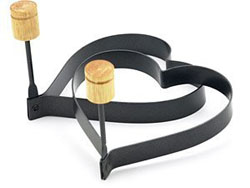
Pancake molds are available in all shapes, from plain round to keep pancakes uniform, to animals, people, and these loving hearts. Click here to purchase. |
PANNEKOEKEN
A pannekoeken is sometimes erroneously called a German pancake. It is a Dutch pancake, and it is different. Pannekoeken is Dutch for pancake: panne = pan, koeken = cake), and is in a pan with rounded (sloping) sides, similar to an omelet pan. A German pancake is made in a casserole dish or baking pan. With pannekoeken, typically (but not always) the fruit or savory filling (think pot pie) is added after the pancake is removed from the oven. With a German pancake, the fruit is baked in the batter. Here’s a pannekoeken recipe.
|
|
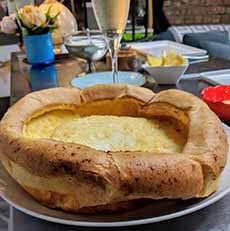
A pannekoeken is baked in a hot oven (photo © House Of Butter). |
PANNUKAKKU (FINNISH OVEN PANCAKE)
A cross between a popover and a Yorkshire pudding, pannukakku is the Finnish version of a Dutch Baby. The custardy batter, with hints of cardamom, is baked in the oven until it puffs up. It can be savory or sweet, depending on the topping. On the sweet side, top it with fruit or jam. On the savory side, top with bacon, sausage, and herbs like tarragon or dill. Pannukakku is traditionally baked in a square pan, but you can use a cast-iron skillet. Here’s a recipe.
|
|
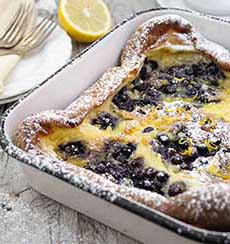
Pannukakku is the Finnish version of a Dutch Baby (photo © Seasons And Suppers).
|
PIKELET
In Australia and New Zealand, a pikelet is a small, thick, colonial-style pancake, related in style to the American silver dollar pancake. It is similarly served in stacks. In Britain, it is known as a drop scone or Scotch pancake. It is also a British regional dialect word, variously denoting a crumpet or muffin.
|
|

Pikelets (photo © Taste Australia). |
|
PIZZELLE
This thin, crispy, golden brown Italian cookie is made from flour, eggs, sugar, butter, and flavorings, such as vanilla, anise, or lemon zest. It’s cooked in a special pizzelle iron, similar to a waffle iron, that has a decorative pattern, typically a snowflake, which is impressed into the cookie. The cookie can be sprinkled with powdered sugar. Unsugared when it is still soft, it can be rolled up into a cone for ice cream.
|
|

A pizzelle maker (photo © Cucina Pro).
|
|
POFFERTJES
These Dutch mini pancakes (POF-fer-chess) are made in a special cast iron pan (poffertjespan) that turns out fluffy, snack-size pancakes. They can be served sweet for breakfast or dessert (with sugar) or savory (with grated Gouda cheese). Instead of making them with yeast, which takes an hour of resting time, they can be made like Swedish aebleskivers, Danish pancakes that are usually made with baking powder as the leavening. Here’s a recipe for the latter.
|
|
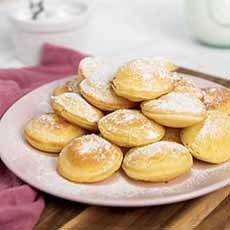
Poffertjes: fluffy mini pancakes, that can be sweet or savory (photo © Feast And West).
|
|
POTATO PANCAKE or LATKE
Potato pancakes are thick mounds of grated potatoes seasoned with grated onions and salt and fried in butter or oil. Potato pancakes are called latkes in the Jewish tradition, but they are a European food and not specifically a Jewish one.
Potato pancakes very likely originated in Eastern Europe, where they are still eaten in large numbers: there are many varieties in northeast Poland, e.g., A favorite Polish dish is placki wegierskie, potato pancakes stuffed with a thick spicy Hungarian goulash.
Potato pancakes are an important part of Jewish cuisine in the United States and Europe. They can be served at any time, but by tradition, they are served in the celebration of Hanukkah. They have no explicit religious significance, but Jews find it appropriate to eat foods cooked in oil during the festival that celebrates the miracle of the Temple oil.
In Israel, where they are known as levivot (singular levivah), potato pancakes are familiar and well-liked. But sufganiyot (jelly doughnuts, singular sufganiyah) are considered to be more Israeli.
Latkes are often eaten with sour cream, applesauce, or both. The French dish commonly known as potato galette is similar, but the sour cream is an ingredient rather than a topping.
The Swedish version of potato pancakes is called raggmunk, which translates to hairy doughnuts (the grated potatoes make them look hairy). They are made from wheat flour, milk, egg, and potatoes, and are fried just like thin pancakes.
If the actual pancake batter is left out, the fried cakes of grated potatoes are called rårakor. Both kinds are enjoyed with fried bacon and/or lingonberry jam.
|
|
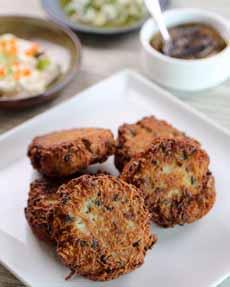
Traditional potato pancakes are often served with applesauce or sour cream (photo © Shaya Restaurant | New Orleans).

Some modern chefs prefer to make the latkes more free-form by grating the ingredients roughly (photo © Vermont Creamery).

Elegant potato pancakes are served with smoked salmon, caviar, or both (photo courtesy Diva Eats World).
|
PUFF PANCAKE
Puff pancake is another name for the Dutch baby pancake: large, oven-baked pancakes. They have puffed-up edges and a soft, custard-like center. Another name is German pancake.
They are made with a thin, eggy batter that is baked in a hot oven, causing it to puff up dramatically.
While the dish is believed to have originated in Germany, the name “Dutch baby” was coined in the United States. As with the term “Pennsylvania Dutch,” American English speakers confused “Deutsch” with “Dutch.
|
|
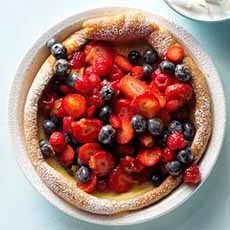
A mixed-berry puff pancake. Here’s the recipe (photo © Taste Of Home).
|
ROTI CANAI and ROTI PRATA
Roti canai or roti chennai (known as roti prata in Singapore) is a savory or sweet pancake dish unique to Malaysia and Singapore. Roti means bread in Hindi and Malay.
The term canai comes from channa, a mixture of boiled chickpeas in a spicy gravy from Northern India with which it was traditionally served.
The dish comprises dough made from copious amounts of fat, egg, flour, water, and clarified butter (ghee). The mixture is kneaded, flattened, oiled, and folded repeatedly. It is then allowed to proof and rise, and the process is repeated. The final round of preparation consists of flattening the dough ball, coating it with oil, and cooking it on a flat iron skillet with a lot of oil. The ideal roti is flat and fluffy on the inside but crispy and flaky on the outside.
Roti prata is predominantly served with curry in Singapore, less commonly with sugar and condensed milk. Although some locals consume roti prata at any time of the day, the vast majority tend to consume it as a late-night or early-morning dish, particularly at 24-hour outlets. It is common to find shops serving roti with flavorings as varied as banana, cheese, chocolate, durian, and garlic.
Continue To Page 6: Terms Beginning With S To Z
Go To The Alphabet Index Above
|
|

Roti Canai (photo © Taste Australia).

Roti canai is commonly served with dal, a lentil-based side, for dipping (photo © Roti N Rice).
|
Some information in this glossary is courtesy of Wikipedia, the free encyclopedia.
|















